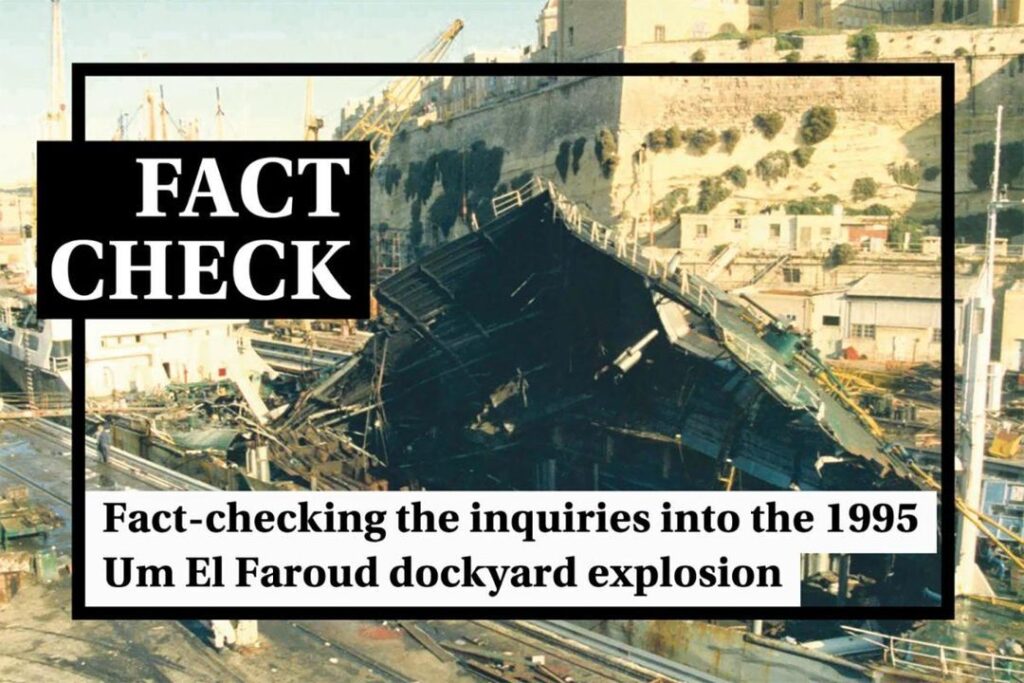A bizarre debate has erupted after Prime Minister Robert Abela harked back to an almost 30-year-old tragedy during a speech delivered on Sunday 3rd March.
Abela was speaking about the recently published inquiry into the death of construction worker Jean Paul Sofia when he drew a parallel with another workplace-related tragedy, the death of nine dockyard workers in an explosion in early 1995.
Abela said that at the time no public inquiry took place, and although the government of the day assumed responsibility for the incident it only paid compensation to the victims’ relatives after dragging them through the courts.
Abela’s claims drew an immediate response from veteran journalist and former PN candidate Dione Borg who, writing on Facebook, said “it is not true that there was no public inquiry”, saying that there was a “public maritime inquiry” into the incident.
It is also not true that the government was found to be responsible for the blast, Borg said, arguing that the inquiry found that the dockyard’s management was to blame, rather than the government.
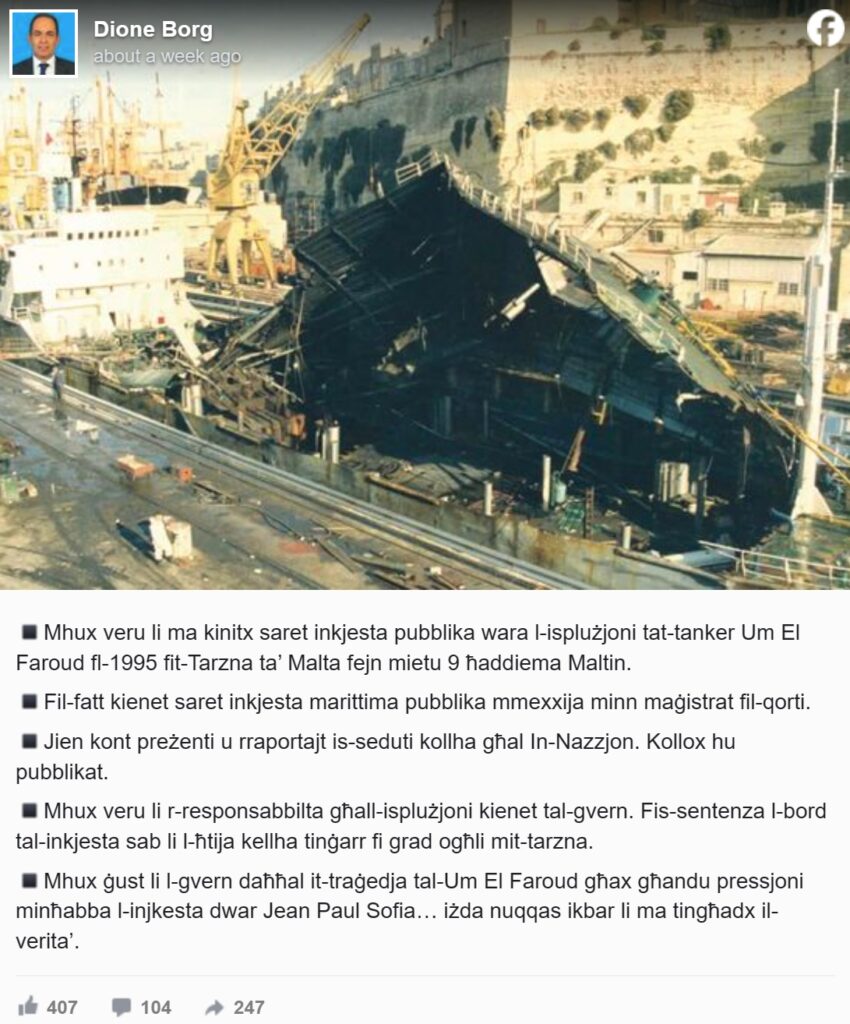
Hundreds of people chimed in, sharing frequently contrasting versions of what happened in the aftermath of the incident. We sifted through newspaper reports of the time to piece the story together.
What is this all about?
The debate refers to one of the darkest chapters of Malta’s industrial history.
On the night of 3rd February 1995, the dockyard was rocked by an explosion on board the 3,000-tonne Libyan tanker Um El Faroud, which was docked for repairs.
The blast killed seven workers on the spot, with another two dying of their injuries shortly afterwards.
The event shocked the nation. A national day of mourning was declared and investigations into the cause of the blast were immediately opened.
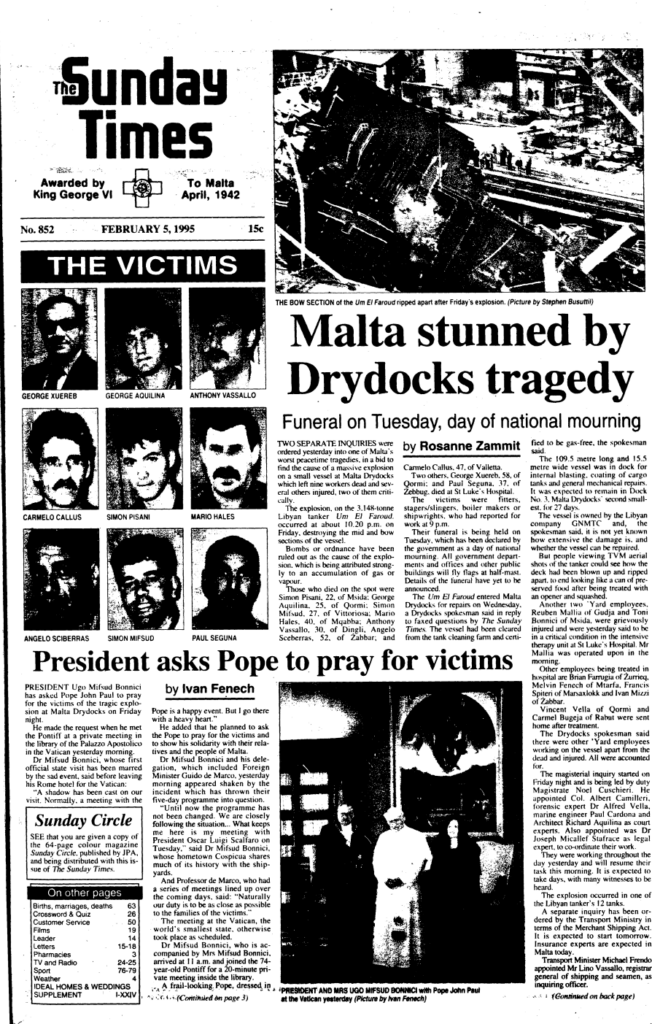
What inquiries were held?
The incident automatically triggered a magisterial inquiry, as is always the case whenever an incident has led to a death or serious injury. The magisterial inquiry was led by then-magistrate Noel Cuschieri, who would go on to become a judge some seven years later.
Cuschieri appointed several experts to help in his work, including the current University rector (and chemistry expert) Alfred Vella, marine engineer Paul Cardona, architect Richard Aquilina, and explosives expert Albert Camilleri.
Alongside the magisterial inquiry, a second, separate inquiry was also launched by then-Transport Minister Michael Frendo.
This inquiry was held under the Merchant Shipping Act, a piece of legislation that gives the minister the power to launch a preliminary inquiry after shipping-related incidents resulting in casualties.
Rather confusingly, this inquiry was also headed by the very same magistrate, Noel Cuschieri, who was in charge of the magisterial inquiry.
In this case, Cuschieri appointed a slightly different set of experts to join his team. While Alfred Vella and Paul Cardona doubled up as members of both inquiries, this time they were joined by industrial chemist Victor Gatt and master mariner Mario Grech.
Years later, several of these experts would go on to file court proceedings against Malta’s transport authorities, claiming that they failed to be paid for their work on the inquiry. The matter was resolved in 2015, two decades after the incident, with the courts ordering authorities to pay their dues.
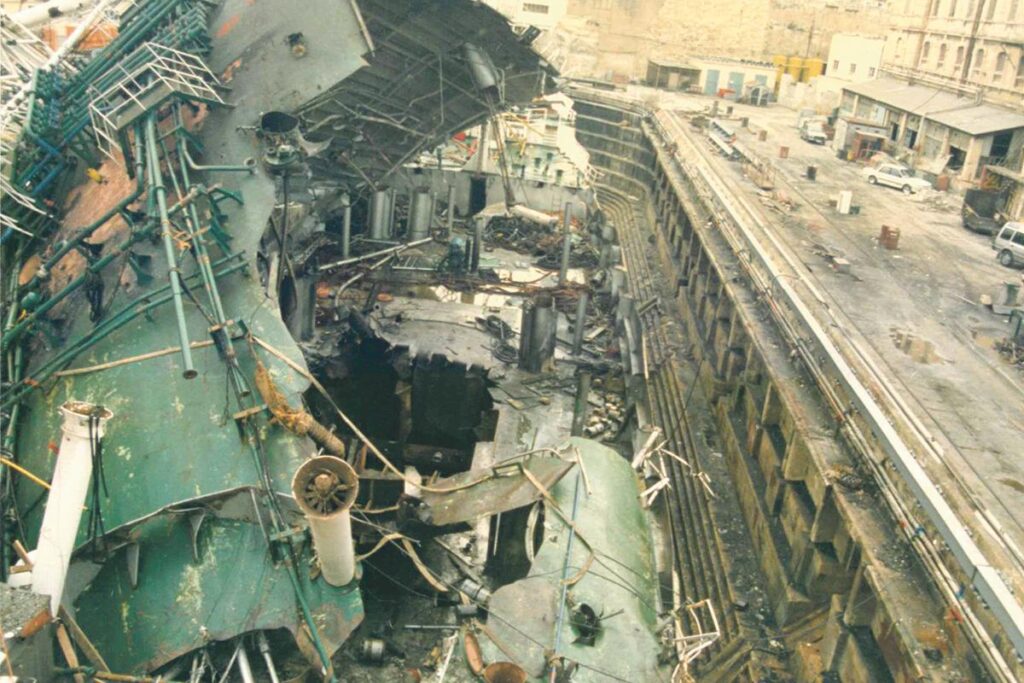
So was this a public inquiry?
Not quite. Unlike public inquiries, which are governed by the Inquiries Act, this was run under an entirely different law, making it a form of administrative inquiry.
This was not unusual at the time – no Maltese government had ever held a public inquiry at this point, with the country’s first ever public inquiry only set to take place a year later, after a bus ticketing scandal erupted in 1996.
The Jean Paul Sofia inquiry board’s report also confirms this version of events, describing itself as Malta’s third-ever public inquiry, after the 1996 bus ticketing inquiry and the more recent Daphne Caruana Galizia inquiry.

But it’s also not quite correct to say that the drydocks inquiry was held entirely behind closed doors, like most other administrative inquiries are.
A Times of Malta report dated 9th February 1995 describes how relatives of the victims were “notified they can attend the inquiry as interested parties”.
Reporters were also allowed to cover much of the testimony in the inquiry, often presenting blow-by-blow accounts of a person’s testimony in the following day’s paper.
However, the inquiry was not open to members of the public to freely attend, in the same way that public inquiries are.
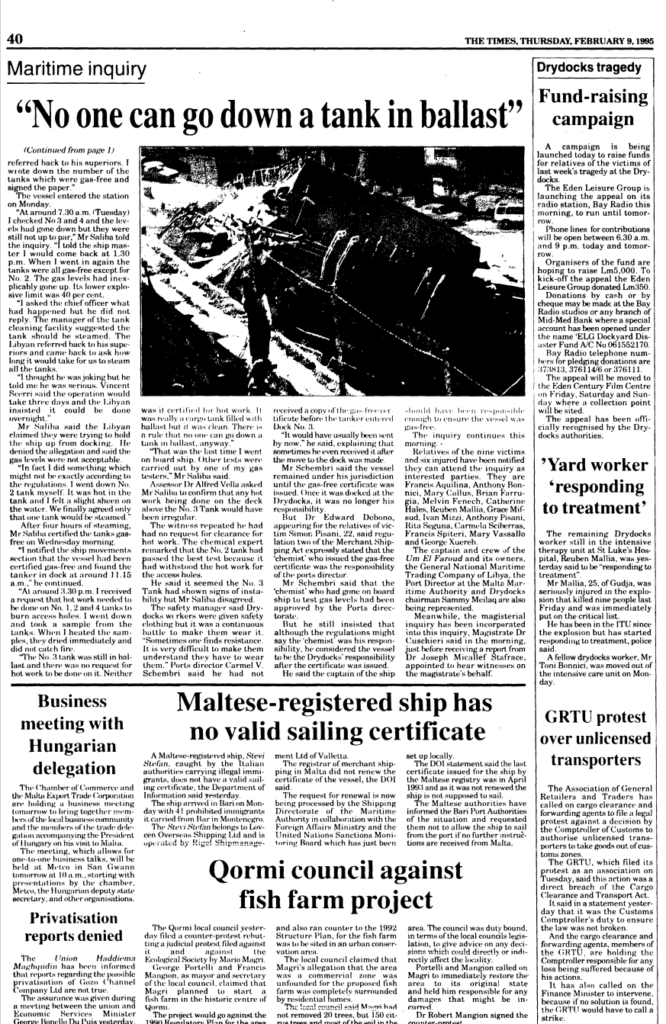
This inquiry also differed from a public inquiry in one significant way. Public inquiries as we know them today are not interested in establishing criminal responsibility, leaving that task to a magisterial inquiry. However, in this case, the magisterial inquiry and the maritime inquiry were very quickly integrated into a single inquiry serving both purposes.
What did the inquiry find?
The inquiry took just under a year to be completed, eventually being presented to parliament in early January 1996.
It found the drydocks’ management to be primarily responsible for the incident, identifying four dockyard workers as liable to face manslaughter charges. It determined that the blast took place after one of the workers who died cut through a valve linked to a tank that had not been properly gas-freed.
Once sparks from the worker’s welding came into contact with the gas, the tank ignited.
But in an unexpected turn of events, the Transport Minister instructed that the inquiry be reheard by the Court of Appeal, just weeks after it was completed, after it emerged that the four workers had not been notified that they were part of the inquiry, as the law required.
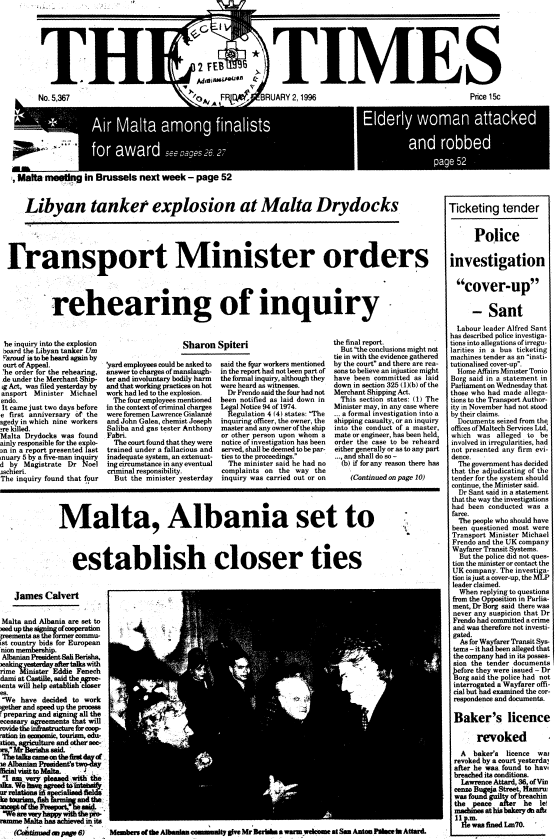
Meanwhile, the victim’s families opened civil action demanding compensation for the loss of their loved ones.
This was eventually resolved in March 2004, when the government and the ship’s Libyan owners reached an agreement with the families to grant compensation and close all court cases. This was revealed in a reply given by then-Minister Austin Gatt in parliament.
By then, almost a decade had passed since the incident took place.
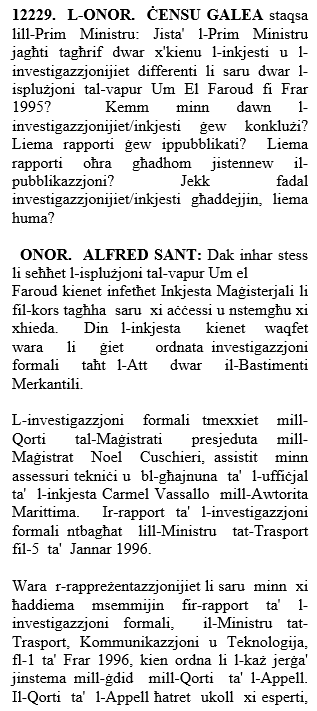
Does this mean that the State was responsible?
Not entirely. Although the drydocks were ultimately a public body, they were run through a self-managed system in which the government had very little say, if at all.
In practice, this meant that the drydocks were managed by a governance board elected entirely by the organisation’s workers.
This system remained in place until 1997 when, faced with reports of catastrophic financial losses and mismanagement, the newly-elected Labour government installed government representatives on the drydocks’ board.
Verdict
There were two inquiries opened after the Um El Faroud tragedy, a magisterial inquiry and an administrative maritime inquiry. Both inquiries were led by the same magistrate and were quickly merged into a single inquiry.
There was no true public inquiry held, since the maritime inquiry was held under a different legal regime to that which governs public inquiries. However, it was also not held entirely behind closed doors, with victims’ families allowed to attend and reporters allowed to report on proceedings.
The inquiry found that the drydocks’ management was to bear the lion’s share of responsibility for the tragedy. Although the drydocks were a public entity and ultimately fell under the State’s responsibility, they were run as a self-managed organisation, with a governance board elected entirely by its workers.
The Times of Malta fact-checking service forms part of the Mediterranean Digital Media Observatory (MedDMO) and the European Digital Media Observatory (EDMO), an independent observatory with hubs across all 27 EU member states that is funded by the EU’s Digital Europe programme. Fact-checks are based on our code of principles.
Let us know what you would like us to fact-check, understand our ratings system or see our answers to Frequently Asked Questions about the service.

